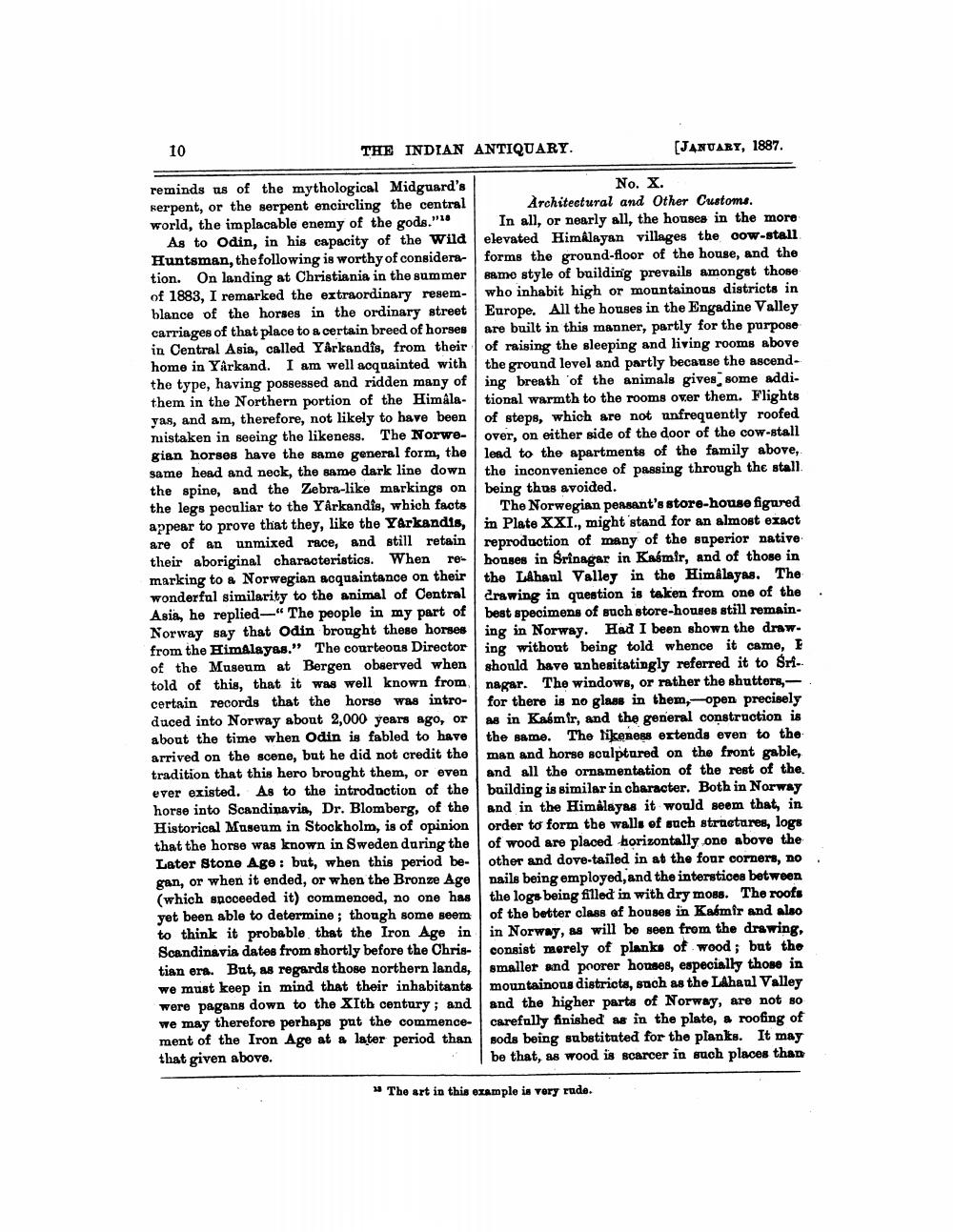________________
10
THE INDIAN ANTIQUARY.
(JANUARY, 1887.
.
reminds us of the mythological Midguard's
No. X. serpent, or the serpent encircling the central Architectural and Other Customs. world, the implacable enemy of the gods." In all, or nearly all, the houses in the more
As to Odin, in his capacity of the Wild elevated Himalayan villages the cow-stall Huntsman, the following is worthy of considera- forms the ground floor of the house, and the tion. On landing at Christiania in the summer same style of building prevails amongst those of 1883, I remarked the extraordinary resem- who inhabit high or mountainous districts in blance of the horses in the ordinary street Europe. All the houses in the Engadine Valley carriages of that place to a certain breed of horses are built in this manner, partly for the purpose in Central Asia, called Yarkandîs, from their of raising the sleeping and living rooms above home in Yarkand. I am well acquainted with the ground level and partly because the ascend the type, having possessed and ridden many of ing breath of the animals gives some addi. them in the Northern portion of the Himála- tional warmth to the rooms over them. Flights yas, and am, therefore, not likely to have been of steps, which are not anfrequently roofed mistaken in seeing the likeness. The Norwe- over, on either side of the door of the cow-stall gian horses have the same general form, the lead to the apartments of the family above, same head and neck, the same dark line down the inconvenience of passing through the stall. the spine, and the Zebra-like markings on being thus avoided. the legs peculiar to the Yarkandis, which facts The Norwegian peasant's store-house figured appear to prove that they, like the Yarkandis, in Plate XXI., might stand for an almost exact are of an unmixed race, and still retain reproduction of many of the superior native their aboriginal characteristics. When re- houses in Srinagar in Kaśmir, and of those in marking to a Norwegian acquaintance on their the Lahaul Valley in the Himalayas. The wonderful similarity to the animal of Central Crawing in question is taken from one of the Asia, he replied—“The people in my part of best specimens of such store-houses still remainNorway say that Odin bronght these horses ing in Norway. Had I been shown the draw. from the HimAlayas." The courteous Director ing without being told whence it came, I of the Museum at Bergen observed when should have unbesitatingly referred it to Sr. told of this, that it was well known from nagar. The windows, or rather the shutters, certain records that the horse was intro- for there is no glass in them, open precisely duced into Norway about 2,000 years ago, or as in Kasmir, and the general construction is about the time when Odin is fabled to have the same. The likeness extends even to the arrived on the scene, but he did not credit the man and horse sculptured on the front gable, tradition that this hero brought them, or even and all the ornamentation of the rest of the. ever existed. As to the introduction of the building is similar in character. Both in Norway horse into Scandinavia, Dr. Blomberg, of the and in the Himalayas it would seem that, in Historical Museum in Stockholm, is of opinion order to form the walls of such stractares, logs that the horse was known in Sweden during the of wood are placed horizontally one above the Later Stone Age: but, when this period be other and dove-tailed in at the four corners, no gan, or when it ended, or when the Bronze Age nails being employed, and the interstices between (which spoceeded it) commenced, no one has the logs being filled in with dry moss. The roofs yet been able to determine ; though some seem of the better class of houses in Kasmir and also to think it probable that the Iron Age in in Norway, as will be seen from the drawing, Scandinavia dates from shortly before the Chris- consist merely of planks of wood; but the tian era. But, as regards those northern lands, smaller and poorer houses, especially those in we must keep in mind that their inhabitants mountainous districts, such as the LAhaul Valley were pagans down to the XItb century; and and the higher parts of Norway, are not so we may therefore perhaps put the commence- carefully finished as in the plate, a roofing of ment of the Iron Age at a later period than sods being substituted for the planks. It may that given above.
be that, as wood is scarcer in such places than
# The art in this example is very rude.




